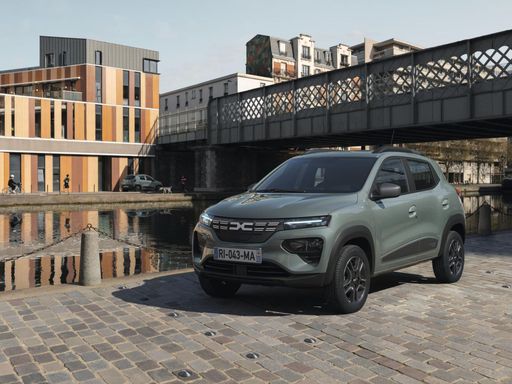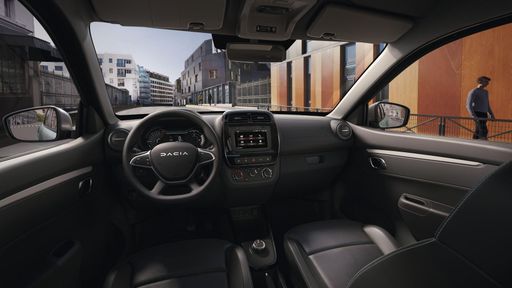Dacia Spring vs Mercedes Citan Transporter – Differences & prices compared
Compare performance, boot space, consumption and price in one view.
Find out now: which car is the better choice for you – Dacia Spring or Mercedes Citan Transporter?
The Dacia Spring (SUV) comes with a Electric engine and Automatic transmission. In comparison, the Mercedes Citan Transporter (Cargo Van) features a Diesel, Petrol or Electric engine with Manuel or Automatic transmission.
When it comes to boot capacity, the Dacia Spring offers 308 L, while the Mercedes Citan Transporter provides – depending on how much space you need. If you’re looking for more power, decide whether the 65 HP of the Dacia Spring or the 131 HP of the Mercedes Citan Transporter suits your needs better.
In terms of consumption, the values are 13.20 kWh per 100 km for the Dacia Spring, and 18.70 kWh5.20 L for the Mercedes Citan Transporter.
Price-wise, the Dacia Spring starts at 14500 £, while the Mercedes Citan Transporter is available from 20200 £. Compare all the details and find out which model fits your lifestyle best!
Dacia Spring
The Dacia Spring stands out as an affordable and environmentally friendly option in the electric vehicle market, combining practicality with a compact design ideal for urban settings. Its minimalist interior, while basic, provides all the essential features needed for a comfortable drive, reflecting its cost-effective approach. The vehicle's performance suits city driving, making it an appealing choice for those seeking an entry-level electric car.
details @ dacia-presse.de
@ dacia-presse.de
 @ dacia-presse.de
@ dacia-presse.de
 @ dacia-presse.de
@ dacia-presse.de
Mercedes Citan Transporter
The Mercedes-Benz Citan van impresses with its versatility and compact design, making it ideal for navigating urban environments with ease. It comes equipped with a stylish yet functional interior, providing drivers with comfort and practicality for both short and long journeys. The Citan also offers advanced safety features, reflecting Mercedes-Benz's commitment to ensuring peace of mind on the road.
details

|
|
|
|
|
Costs and Consumption |
|
|---|---|
|
Price
14500 - 17100 £
|
Price
20200 - 34000 £
|
|
Consumption L/100km
-
|
Consumption L/100km
5.2 - 6.9 L
|
|
Consumption kWh/100km
13.2 - 14.1 kWh
|
Consumption kWh/100km
18.7 - 21.1 kWh
|
|
Electric Range
225 - 228 km
|
Electric Range
262 - 290 km
|
|
Battery Capacity
26.80 kWh
|
Battery Capacity
45 kWh
|
|
co2
0 g/km
|
co2
0 - 157 g/km
|
|
Fuel tank capacity
-
|
Fuel tank capacity
54 L
|
Dimensions and Body |
|
|---|---|
|
Body Type
SUV
|
Body Type
Cargo Van
|
|
Seats
4
|
Seats
2 - 5
|
|
Doors
5
|
Doors
4 - 5
|
|
Curb weight
1013 - 1050 kg
|
Curb weight
1381 - 1939 kg
|
|
Trunk capacity
308 L
|
Trunk capacity
-
|
|
Length
3701 mm
|
Length
4498 - 4922 mm
|
|
Width
1583 mm
|
Width
1859 mm
|
|
Height
1519 mm
|
Height
1819 - 1830 mm
|
|
Payload
265 - 302 kg
|
Payload
449 - 787 kg
|
Engine and Performance |
|
|---|---|
|
Engine Type
Electric
|
Engine Type
Diesel, Petrol, Electric
|
|
Transmission
Automatic
|
Transmission
Manuel, Automatic
|
|
Transmission Detail
-
|
Transmission Detail
Manual Gearbox, Dual-Clutch Automatic
|
|
Drive Type
Front-Wheel Drive
|
Drive Type
Front-Wheel Drive
|
|
Power HP
44 - 65 HP
|
Power HP
75 - 131 HP
|
|
Acceleration 0-100km/h
13.7 - 19.1 s
|
Acceleration 0-100km/h
11.7 - 18 s
|
|
Max Speed
125 km/h
|
Max Speed
132 - 183 km/h
|
|
Torque
113 - 125 Nm
|
Torque
200 - 270 Nm
|
|
Number of Cylinders
-
|
Number of Cylinders
4
|
|
Power kW
33 - 48 kW
|
Power kW
55 - 96 kW
|
|
Engine capacity
-
|
Engine capacity
1332 - 1461 cm3
|
General |
|
|---|---|
|
Model Year
2024
|
Model Year
2021 - 2024
|
|
CO2 Efficiency Class
A
|
CO2 Efficiency Class
E, F, D, A
|
|
Brand
Dacia
|
Brand
Mercedes-Benz
|
Dacia Spring
The Revolution of Affordable Electric Mobility: The Dacia Spring
The automotive world has witnessed remarkable advancements in electric vehicles (EVs), with the Dacia Spring emerging as a noteworthy contender in the affordable segment. Combining efficiency, affordability, and practicality, the Spring offers an intriguing prospect for eco-conscious individuals and city dwellers alike.
Powertrain and Performance: A Look Under the Hood
The Dacia Spring is equipped with an electric motor that delivers between 44 to 65 PS, translating into a versatile driving experience tailored to urban landscapes. It operates on a front-wheel-drive system, ensuring a familiar and manageable handling experience.
Dacia Spring's electric engine is paired with an automatic transmission, utilising a reduction gearbox. This setup allows for smooth acceleration and a top speed of 125 km/h, ensuring that everyday driving scenarios are handled with ease.
Efficiency and Range: Eco-Friendly without Compromise
Efficiency is a cornerstone of the Dacia Spring's design, boasting an energy consumption of just 13.2 to 14.1 kWh per 100 km. When fully charged, its 26.8 kWh battery offers a respectable range of 225 to 228 km, making it ideal for daily commutes and short trips.
Furthermore, the Spring takes pride in its commendable CO2-efficiency class A, emphasising its commitment to reducing environmental footprint with a zero-emission profile.
Design and Practicality: Compact yet Comprehensive
Lying in the SUV category, the Dacia Spring is compact with dimensions of 3701 mm in length and 1583 mm in width, making it a perfect match for urban environments where space is at a premium. Despite its modest size, it provides a generous boot space of 308 litres, ensuring practicality isn’t sacrificed.
Comfort and Interior: For the Everyday Journey
The Dacia Spring comfortably seats up to four passengers. The cabin offers a minimalist yet functional design, available in multiple trim lines including Essential, Expression, and Extreme, allowing customers to choose according to their taste and requirement.
With its ergonomic layout and simplicity, the interior is crafted to enhance the driving experience by focusing on essential needs, avoiding unnecessary distractions.
Affordability and Accessibility: Breaking Barrier
The Dacia Spring stands out in the electric vehicle market due to its affordability, with prices ranging from 16,900 to 19,900 €. This ensures that environmentally friendly transportation is accessible to a broader audience.
Additionally, the Spring allows for cost-effective maintenance and operational expenses, offering monthly running costs between 570 to 599 € and cost per km between 22.8 to 24 cents, making it an economical choice in the long run.
Final Thoughts: The Future of Urban Mobility
In summary, the Dacia Spring serves as a testament to how electric vehicles can be both affordable and practical, without compromising on essential features. Whether it is for the eco-conscious urbanite or those looking for a cost-effective daily driver, the Spring is positioned as a viable solution for navigating the future of urban mobility.
Mercedes Citan Transporter
Discovering the Mercedes-Benz Citan: A Transporter's Tale
The Mercedes-Benz Citan is not just a vehicle; it's a versatile transporting champion designed to meet the varied needs of professionals and small businesses alike. Whether you're navigating urban environments or embarking on longer journeys, the Citan offers a range of options that blend performance with efficiency and innovation. Here, we explore what makes the Citan a standout in its class.
Engine Choices and Performance
The Citan provides a comprehensive range of engine options tailored to different needs. Customers can choose from diesel, petrol, and fully electric variants, each offering a fine balance of power and efficiency. Diesel engines range from 75 to 116 PS, with a fuel efficiency of up to 5.2 L/100km. For those preferring petrol, the engines go up to 131 PS, holding a fuel efficiency of 6.6 to 6.9 L/100km. Meanwhile, the electric eCitan offers up to 122 PS and a range of up to 290 km on a single charge, a perfect choice for those seeking sustainable transport solutions.
Innovative Transmission and Drive
Mercedes-Benz has equipped the Citan with state-of-the-art transmission options, including a six-speed manual and automatic variant for the diesel and petrol models. For the electric eCitan, an advanced automatic transmission assists in managing the electric motor's power output efficiently. All models boast front-wheel drive, ensuring nimble handling and ease of use in both urban traffic and on open roads.
Modern Convenience and Capacity
Designed with practicality in mind, the Citan does not skimp on cargo space. The transporter offers a loading capacity from 2,500 to 3,000 litres, with a payload ranging from 449 kg to an impressive 753 kg, depending on the model. The versatility is further expanded by a selection of seating arrangements, from two up to five seats, making it suitable for diverse applications from deliveries to passenger transport.
Dimensions and Design
Standing between 4,498 mm and 4,922 mm in length, the Citan navigates city streets and narrow lanes with ease. Its compact width of 1,859 mm is complemented by a height range of 1,819 to 1,830 mm, ensuring a spacious feel without compromising on manoeuvrability. The sleek design is not only aerodynamic for enhanced efficiency but also unmistakably Mercedes-Benz in its aesthetic appeal.
Technology and Safety Features
Mercedes-Benz is synonymous with safety, and the Citan is no exception. It comes pre-equipped with a suite of advanced safety features like adaptive cruise control, lane-keeping assistance, and emergency braking systems. Facilitating a safer drive, each model includes several efficiency-boosting technologies focused on reducing CO2 emissions and fuel consumption.
Customisation and Price Range
The Citan is available at various trim levels, like Base and Pro, which can incorporate manual or automatic transmissions. With pricing ranging from €25,031 to €42,629, the Citan can be tailored to suit specific budgets and operational needs, ensuring that businesses can find the perfect fit for their requirements.
In summary, the Mercedes-Benz Citan integrates robust performance, innovative technologies, and adaptability, making it a reliable partner, regardless of business or personal needs. It's a vehicle ready to conquer the challenges of modern transport with reliability and style.
Which drive types are available for the Dacia Spring?
Available as .
The prices and data displayed are estimates based on German list prices and may vary by country. This information is not legally binding.
